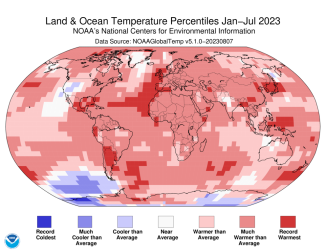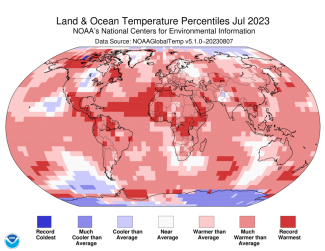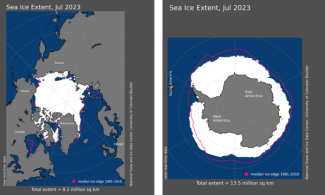Earth had its warmest July on record; fourth consecutive month of record-high global ocean surface temperature

July Highlights:
- Antarctica saw its third-consecutive month of record-low sea ice extent.
- July 2023 set a record for the highest monthly sea surface temperature anomaly (+1.78°F or +0.99°C) of any month in NOAA’s 174-year record.
- South America had a record-breaking July, with its highest monthly temperature anomaly ever recorded at 3.94°F (2.19°C) above the July average.
- Hurricane Don became the first Atlantic hurricane of the season, and with a duration of 10 days including its time as a subtropical storm; Don became the fifth longest-lasting Atlantic storm for July.
Globally, July 2023 set a record for the warmest July in the 174-year NOAA record. The year-to-date (January–July) global surface temperature ranked as the third warmest such period on record. According to NCEI’s Global Annual Temperature Outlook and data through July, it is virtually certain (> 99.0%) that the year 2023 will rank among the five-warmest years on record with a nearly 50% probability that 2023 will rank warmest on record.
This monthly summary, developed by scientists at NOAA’s National Centers for Environmental Information, is part of the suite of climate services NOAA provides to government, business, academia and the public to support informed decision-making.
Monthly Global Temperature
The July global surface temperature was 2.02°F (1.12°C) above the 20th-century average of 60.4°F (15.8°C), making it the warmest July and likely the warmest month in NOAA’s 174-year record. This marked the first time a July temperature exceeded 1.8°F (1.0°C) above the long-term average. July 2023 was 0.36°F (0.20°C) warmer than the previous July record from 2021, but the anomaly was 0.41°F (0.23°C) lower than the all-time highest monthly temperature anomaly on record (March 2016). July 2023 marked the 47th-consecutive July and the 533rd-consecutive month with temperatures at least nominally above the 20th-century average.
Climatologically, July is the warmest month of the year. As the warmest July on record, July 2023, at least nominally, was the warmest month on record for the globe. For the fourth-consecutive month, global ocean surface temperature hit a record high. El Niño conditions that emerged in June continued into July, and on July 13 NOAA’s Climate Prediction Center issued a statement announcing a greater than 90% chance that El Niño will continue through the Northern Hemisphere winter. Globally, July 2023 set a record for the highest monthly sea surface temperature anomaly (+1.78°F or +0.99°C) of any month in NOAA’s 174-year record. July’s sea surface temperature anomaly was 0.12°F (0.07°C) higher than the previous record-high anomaly set in June 2023.
Asia, Africa, and South America each had their warmest July on record. South America had its highest monthly temperature anomaly of any month on record at 3.94°F (2.19°C). North America had its second-warmest July and Europe had its eighth-warmest July. July in Oceania ranked 11th warmest on record. Both the Gulf of Mexico and the Caribbean Islands region experienced their warmest July on record. The Atlantic “Main Development Region”, a region of the tropical Atlantic Ocean basin which extends from offshore the west coast of Africa to the westernmost sections of the Caribbean Sea that is closely monitored for potential Atlantic tropical system development, also experienced its warmest July on record.
Temperatures were above average throughout most of South America, Europe, Africa and Asia. Parts of northern, southern and western North America, Australia and northern and southern Oceania also experienced warmer-than-average temperatures this month. Sea surface temperatures were above average across much of the northern, central and western Pacific, the Atlantic and the Indian Ocean. Parts of the central Atlantic, the southwestern Pacific, the southern Indian Ocean, as well as parts of northeastern and northwestern Canada, the southwest U.S., Mexico, southwestern Europe, Africa, and central and southern Asia saw record-warm July temperatures. Record-warm temperatures covered just over 9.3% of the world’s surface this month, which marks the highest July percentage since records began in 1951.
Temperatures were near to cooler than average across parts of the central U.S. and Canada, Greenland, western Russia, Pakistan and northern India, western Oceania, southern Africa and Antarctica. Sea surface temperatures were near to below average over parts of the central-eastern and southeastern Pacific, the Arctic Ocean and the southeastern Indian Ocean. Less than 1% of the world's surface had a record-cold July.
Sea Ice Extent
July 2023 set a record for the lowest global July sea ice extent on record. Globally, sea ice extent in July 2023 was about 470,000 square miles less than the previous record low from July 2019. Sea ice extent in Antarctica continued to track at record lows; Antarctica saw its third-consecutive month with the lowest sea ice extent on record.
The Arctic sea ice extent for July 2023 ranked as the 12th smallest in the satellite record at 3.16 million square miles, or about 220,000 square miles below the 1991–2020 average. The Antarctic sea ice extent ranked lowest on record at 5.21 million square miles, or about 1 million square miles—roughly the size of Argentina—below the 1991–2020 average. This was 580,000 square miles below the previous record low from July 2022.
Global Precipitation
Below-average July precipitation was observed across parts of the western U.S., Central America, Brazil, southwestern Europe and southern Australia. Wetter-than-average conditions were present across parts of the eastern U.S., northwestern Europe, northwestern Russia, western India and Pakistan. The Asian monsoon areas were dominated by positive rainfall anomalies and saw associated floods and landslides. Globally, July 2023 ranked among the wettest Julys on record.
Global Tropical Cyclones
Eight named storms occurred across the globe in July, which is near the 1991–2020 average of 9.6. Seven of those reached tropical cyclone strength (≥74 mph), including three that reached major tropical cyclone strength (≥111 mph). These counts are both above the 1991–2020 averages for July. The global accumulated cyclone energy, an integrated metric of the strength, frequency, and duration of tropical systems, was near the July climatological average. Hurricane Don was the first Atlantic hurricane of the season, and with a duration of 10 days including its time as a subtropical storm, Don became the fifth longest-lasting Atlantic storm for July.
For a more complete summary of climate conditions and events, see our July 2023 Global Climate Report or explore our Climate at a Glance Global Time Series.







